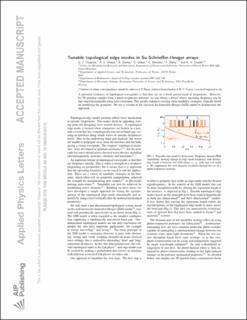| dc.contributor.author | Chaplain, G.J. | |
| dc.contributor.author | Gliozzi, A.S. | |
| dc.contributor.author | Davies, B. | |
| dc.contributor.author | Urban, David | |
| dc.contributor.author | Descrovi, Emiliano | |
| dc.contributor.author | Bosia, F. | |
| dc.contributor.author | Craster, R.V. | |
| dc.date.accessioned | 2024-01-17T13:14:28Z | |
| dc.date.available | 2024-01-17T13:14:28Z | |
| dc.date.created | 2023-06-15T14:24:50Z | |
| dc.date.issued | 2023 | |
| dc.identifier.citation | Applied Physics Letters. 2023, 122 (22), . | en_US |
| dc.identifier.issn | 0003-6951 | |
| dc.identifier.uri | https://hdl.handle.net/11250/3112197 | |
| dc.description.abstract | A potential weakness of topological waveguides is that they act on a fixed narrow band of frequencies. However, by 3D printing samples from a photo-responsive polymer, we can obtain a device whose operating frequency can be fine-tuned dynamically using laser excitation. This greatly enhances existing static tunability strategies, typically based on modifying the geometry. We use a version of the classical Su–Schrieffer–Heeger model to demonstrate our approach. | en_US |
| dc.language.iso | eng | en_US |
| dc.publisher | American Institute of Physics | en_US |
| dc.rights | Navngivelse 4.0 Internasjonal | * |
| dc.rights.uri | http://creativecommons.org/licenses/by/4.0/deed.no | * |
| dc.title | Tunable topological edge modes in Su-Schrieffer-Heeger arrays | en_US |
| dc.title.alternative | Tunable topological edge modes in Su-Schrieffer-Heeger arrays | en_US |
| dc.type | Peer reviewed | en_US |
| dc.type | Journal article | en_US |
| dc.description.version | acceptedVersion | en_US |
| dc.source.pagenumber | 0 | en_US |
| dc.source.volume | 122 | en_US |
| dc.source.journal | Applied Physics Letters | en_US |
| dc.source.issue | 22 | en_US |
| dc.identifier.doi | 10.1063/5.0152172 | |
| dc.identifier.cristin | 2154954 | |
| dc.relation.project | Norges teknisk-naturvitenskapelige universitet: 989454111 | en_US |
| cristin.ispublished | true | |
| cristin.fulltext | postprint | |
| cristin.qualitycode | 2 | |

